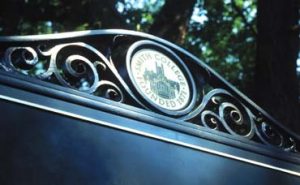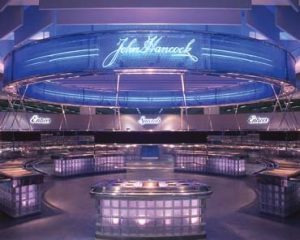As a college student, Jon Roll had planned to become an architect. But after having worked as an apprentice in architecture firms during college, he determined architecture’s career ladder was too long to climb before he’d receive any significant design responsibilities — and he was ready to use his creativity.
So, Roll — after a three-year career hiatus when he was drafted into the Army in Vietnam — pursued a graduate degree in graphic design.
Everything came full circle for Roll when he began designing graphics and signage for architectural projects, thus merging his interests.
Roll worked as a designer for advertising and architecture agencies in Sweden, Mexico and Colombia. Prior to launching his own firm, Jon Roll & Assoc. (JRA), in 1988 in Cambridge, MA, he was responsible for the environmental-graphic design activities of Herman and Lees Assoc. (Cambridge).
Teamwork
JRA specializes in signage and graphic-design programs for various facilities, including universities, office parks, hospitals and museums, much of which is new construction that requires a close working relationship with a project’s architect.
Roll said creating architectural signs and graphics offers a happy medium between architecture and traditional graphic design. Sometimes, [other types of] graphic design can be too frenetic, and architecture can be too long and drawn out,” Roll said. “We end up at a good place in between.”
He enjoys his firm’s specialized work because it fosters good collaboration with many other creative minds, including architects, interior designers, light designers, landscape architects and others.
His designers work in teams of two — a project manager and an assistant — and handle 10 to 20 projects at once, each in a different development stage. Each team sees its projects through from inception to completion. Continuity on a project is important, Roll said.
Andrew Barresi, a nine-year JRA associate who worked as a civil engineer before joining Roll, said that, because it’s a small firm (a dozen people work in the office), each employee handles projects from top to bottom, including every detail. In addition to serving as designers and project managers, they develop marketing materials, handle sales — even empty the trash, Barresi said.
The team system “allows for good ownership of a project,” Roll said. “When you’re designing, you also have to be thinking about how to build it and the associated costs,” instead of just designing it and passing it along to another staff member for its construction details.
Most projects deal with designing contextual signage and graphics for a building under construction. Projects typically last one to two years.
“Part of the workflow is to have people on a variety of projects, so each team doesn’t have too many of the same projects going at once,” Roll said. Some projects, like the signage system for a hospital, require much more detail than others.
Roll said their workflow is similar to an architect’s. They begin with an evaluation phase and then move on to design development, construction documentation, bidding assistance and construction supervision.
Because much of the firm’s work revolves around architectural projects, Roll’s designers use the AIA model of preparing drawings and documents so they can easily integrate with the architect’s plans.
JRA either works directly for the building’s owner or the architect. Roll said most of his work is in the Northeast. When they work outside the region, it’s usually under the auspices of a Northeastern architecture firm that landed a job elsewhere.
Following through
Project managers visit a building site throughout the project, starting during a project’s kickoff. For example, Roll said, when working on a university project, the design team will visit the site to get a feel for the campus. Trips away from the office also include a visit to the fabricator’s shop to check on progress.
Fabrication is sent out to bid by the contractor or owner. Prior to bid, Roll said they compile the drawings and specifications and also recommend bidders. Roll generally recommends five sign companies whom they deal with regularly. The contractor/owner doesn’t always take their recommendation – price and location come into play.
Designers create the detailed drawings, specify all the signs’ materials and coordinate any electrical or installation needs with the architects.
“Usually, we are doing the last thing to go into a building, so it makes it more important to be involved every step of the way,” Roll said. They specify all materials, which typically results in tight, accurate bids. The signshop hired usually sticks with the designer’s specifications exactly, though a signmaker will occasionally suggest another material.
Multitasking
Barresi said the most challenging and rewarding aspect of the designer’s job is “developing creative ideas unique to each project to meet a client’s needs, without repeating yourself.
“You have to try and be creative in the midst of being very busy,” Barresi said. “You have to approach each project as if it’s the only project you’re working on. You have to try and look at each project with fresh eyes, because that’s what each project deserves. Our clients know we’re going to approach their project individually.
Constantly challenging themselves to remain creative, in the face of deadlines and a mounting workload, can ultimately lead to project satisfaction. One of Barresi’s favorite recent projects was the signage program for Brandeis University.
“The design really resonates with who they are. I was proud because they’re happy with the design and program. It’s a diverse community and was an inclusive project where we needed to take into account all of their needs.”
The user group is very important in the design process, senior designer Anna Farrington said. Designers must constantly think of how the users will utilize the signs.
Farrington said there’s always something to do at JRA. “Usually ‘multitasking’ is the word of the day,” she said. “Environmental graphic design is more than just design. There’s a lot of research and data handling as well.”
Farrington said “designing by committee” often presents project challenges. When too many people try to make final design decisions, things may not run smoothly and efficiently.
Fast-track projects are often difficult to manage. If a construction schedule is too aggressive, Roll said, steel frames might go up while architects are still designing the building. On JRA’s end, this hinders building-graphics coordination. “We’ll design signs and then find that a wall in the plans wasn’t constructed,” Roll said.
The most successful and “favorite” projects are those which come together easily in a cohesive final project. Roll said his favorites are those with good coordination of all project players and a good relationship with the building’s owner. With so many different components to a large architectural project, the “perfect” project is a rarity, but all projects offer a sense of accomplishment upon completion.


 Tip Sheet1 week ago
Tip Sheet1 week ago
 Photo Gallery3 days ago
Photo Gallery3 days ago
 Ask Signs of the Times5 days ago
Ask Signs of the Times5 days ago
 Real Deal2 weeks ago
Real Deal2 weeks ago
 Benchmarks1 week ago
Benchmarks1 week ago
 Photo Gallery10 hours ago
Photo Gallery10 hours ago
 Paula Fargo10 hours ago
Paula Fargo10 hours ago
 Women in Signs2 weeks ago
Women in Signs2 weeks ago














